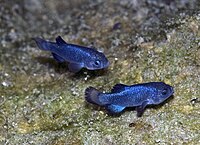
Photo from wikipedia
Small populations with limited range are often threatened by inbreeding and reduced genetic diversity, which can reduce fitness and exacerbate population decline. One of the most extreme natural examples is… Click to show full abstract
Small populations with limited range are often threatened by inbreeding and reduced genetic diversity, which can reduce fitness and exacerbate population decline. One of the most extreme natural examples is the Devils Hole pupfish (Cyprinodon diabolis), an iconic and critically endangered species with the smallest known range of any vertebrate. This species has experienced severe declines in population size over the last 30 years and suffered major bottlenecks in 2007 and 2013, when the population shrunk to 38 and 35 individuals, respectively. Here, we analysed 30 resequenced genomes of desert pupfishes from Death Valley, Ash Meadows and surrounding areas to examine the genomic consequences of small population size. We found extremely high levels of inbreeding (FROH = 0.34–0.81) and an increased amount of potentially deleterious genetic variation in the Devils Hole pupfish as compared to other species, including unique, fixed loss-of-function alleles and deletions in genes associated with sperm motility and hypoxia. Additionally, we successfully resequenced a formalin-fixed museum specimen from 1980 and found that the population was already highly inbred prior to recent known bottlenecks. We thus document severe inbreeding and increased mutation load in the Devils Hole pupfish and identify candidate deleterious variants to inform management of this conservation icon.
Journal Title: Proceedings of the Royal Society B: Biological Sciences
Year Published: 2022
Link to full text (if available)
Share on Social Media: Sign Up to like & get
recommendations!